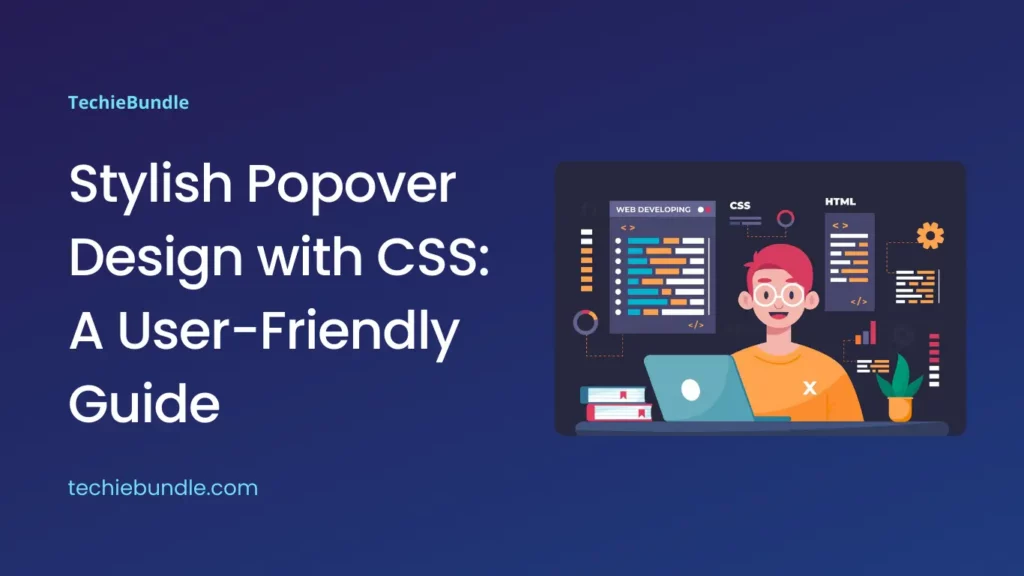Stylish Popover Design with CSS: Intro
A stylish popover design with CSS is a useful and versatile user interface element that can be used to display additional information, options, or actions when the user interacts with a specific area of a web page or application. With CSS, you can create beautiful and functional popovers that enhance the user experience and make your design stand out.
To create a popover with CSS, you’ll need to start by defining the HTML structure of the popover and its trigger element. Typically, the trigger element is a button or a link that the user can click or hover over to activate the popover. The popover itself can contain any content you like, such as text, images, forms, or even embedded videos.
Once you have the HTML structure in place, you can use CSS to style the popover and its trigger element. You can set the size, position, background color, border, and other visual properties of the popover, as well as add animations and transitions to make it more engaging and interactive.
One popular technique for creating popovers with CSS is to use the “:hover” pseudo-class to apply styles when the user hovers over the trigger element. You can also use the “:focus” pseudo-class to style the popover when the trigger element is in focus, such as when the user tabs to it with the keyboard.
Another option is to use JavaScript to create more advanced popovers that respond to user interactions, such as clicks or taps. You can use a library such as jQuery or Popper.js to handle the positioning and behavior of the popover, while still using CSS to style it.
Overall, creating a popover with CSS can be a fun and rewarding project that can add value to your design and improve the user experience. With a little creativity and some knowledge of CSS and HTML, you can create popovers that are both functional and beautiful.
Author
- TechieBundle
- April 02, 2023
Live Demo
Code
You can check the code used in the demo below which you can also use in your projects.
HTML
<!-- tb is acronym for TechieBundle -->
<div class="tb-pop-container">
<a href="//techiebundle.com" target="_blank">
<h1>TechieBundle: Get More Template Click Here... </h1>
</a>
<div class="tb-popover-wrapper">
<h2 class="tb-popover-title">Hover on Button</h2>
<div class="tb-popover-content">
<img src="//techiebundle.com/wp-content/uploads/2022/12/techiebundle-white-1-1.png" alt="Web Development Agency | TechieBundle">
<ul class="tb-popover-message">
<li><a href="//techiebundle.com" target="_blank">TechieBundle</a></li>
<li>Web Development</li>
<li>HTML | CSS | JavaScript</li>
</ul>
</div>
</div>
</div>
CSS
html,
body {
background-color: #d5a56e;
max-width: 768px;
margin: 0 auto;
padding: 1em 0;
font-family: "Helvetica Neue", Helvetica, Arial, sans-serif;
width: 100%;
height: 100%;
text-align: center;
}
a {
text-align: center;
text-decoration: none;
color: #252525;
}
a > h1 {
margin: 0.35em 0;
}
a:hover {
text-decoration: underline;
}
.tb-popover-title {
font-size: 24px;
line-height: 36px;
text-decoration: none;
color: rgba(255, 255, 255, 88%);
text-align: center;
padding: 15px 0;
cursor: pointer;
margin: 0;
padding: 10px 1em;
background: #b75454;
border-radius: 8px;
}
.tb-popover-wrapper {
position: relative;
margin: 2em 0;
display: inline-block;
}
.tb-popover-content {
opacity: 0;
visibility: hidden;
position: absolute;
transform: translate(0, 10px);
background: #b75454;
padding: 1.5rem;
width: 100%;
border-radius: 16px;
left: -1.5em;
}
.tb-popover-content > img {
width: 100px;
height: 100px;
border-radius: 50%;
}
.tb-popover-content:before {
position: absolute;
z-index: -1;
content: "";
right: calc(50% - 10px);
top: -8px;
border-style: solid;
border-width: 0 10px 10px 10px;
border-color: transparent transparent #b75454 transparent;
transition-duration: 0.3s;
transition-property: transform;
}
.tb-popover-wrapper:hover .tb-popover-content {
z-index: 10;
opacity: 1;
visibility: visible;
transform: translate(0, 0.5em);
transition: all 0.5s cubic-bezier(0.75, -0.02, 0.2, 0.97);
}
.tb-popover-message {
text-align: center;
color: #edd3d4;
font-weight: 600;
padding: 0;
text-align: center;
list-style-type: none;
line-height: 2;
font-size: 17px;
}
.tb-popover-message > li > a {
color: #edd3d4;
}
Technologies Used
- HTML / CSS
About the code
Compatible browsers:- Chrome, Edge, Firefox, Opera, Safari
Responsive:- Yes
Dependencies: – N/A
Conclusion
In conclusion, a stylish popover design with CSS is a valuable UI element that can enhance the user experience by providing additional information or functionality in a visually appealing way. By combining HTML and CSS, you can create popovers that are both functional and aesthetically pleasing. You can use CSS to define the size, position, color, and other visual properties of the popover, and you can use JavaScript to add interactivity and functionality. With a little creativity and attention to detail, you can create popovers that are sure to delight your users and improve the overall usability of your web page or application.
Note: When designing a popover, it’s important to keep the user’s experience in mind. Make sure the popover is easy to trigger and dismiss, and that its content is relevant and helpful to the user. Consider using a consistent design and placement for popovers throughout your website or application, so that users can quickly learn how to use them. Finally, test your stylish popover design with CSS thoroughly to make sure it works well on different devices and screen sizes, and that it doesn’t interfere with other elements on the page.
Also Check: Card Flip on Hover Animation using Pure HTML and CSS



